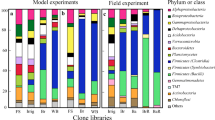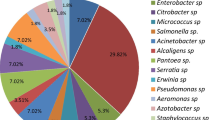Abstract
Tare soil is soil attached to harvested products like potato tubers. Tare soil becomes a considerable waste stream after storage, washing and processing of harvested products. There is a high risk on contamination of tare soils with (quarantine) phytopathogens, because of import of harvested products from different regions of the world. Disinfestation is necessary to make tare soils applicable for agricultural production. Anaerobic (non-chemical) soil disinfestation (ASD) and inundation are suitable methods to disinfest tare soils. Two different soils (marine loam and glacial sand) were either treated with five (2011) or four (2012) treatments and these were: (i) no treatment (control), (ii) freshly cut grass, (iii) Herbie 7025, (iv) inundation (five cm water on top of the soil surface), and (v) combination of Herbie 7025 and inundation (2011 only). Containers with treated and untreated soils were inoculated with two quarantine phytopathogens, Ralstonia solanacearum biovar 2 and Globodera pallida. After soil inoculation, the containers were airtight closed and only opened for destructive sampling after 84 days. Then, soils were analysed for the presence of R. solanacearum biovar 2, using immunofluorescence colony staining, and for the presence of viable G. pallida eggs, determined by the number of juveniles hatched from eggs and lured to potato root exudate. Strong (> 99.4 %) declines of both pathogens in treated versus the appropriate control soils were observed. Repetition of the experiment revealed the same pattern and therefore it was concluded that ASD and inundation, as separate treatments, have promise for remediation of tare soils from contaminating quarantine pathogens.


Similar content being viewed by others
References
Been, T. H., & Schomaker, C. H. (1998). Quantitative studies on the management of potato cyst nematodes (Globodera spp.) in the Netherlands. PhD thesis Wageningen University, Wageningen, The Netherlands.
Dablowska-Naskret, H., Bartkowiak, A., Dhugosz, J., & Rózanski, S. (2009). The quality of soil tare from the sugar beet plant with regard to its utilization for soil fertilization. Contemporary Problems of Management and Environmental Protection, 4, 171–178.
Goud, J. K., Termorshuizen, A. J., Blok, W., & Van Bruggen, A. H. C. (2004). Long-term effect of biological soil disinfestation on Verticillium wilt. Plant Disease, 88, 688–694.
Ludeking, D. J. W., Paternotte, S. J., Runia, W. T., & Molendijk, L. P. G. (2011). Biological soil disinfestation with organic fermentation products. Acta Horticulturae, 915, 133–139.
Messiha, N., Van Diepeningen, A. D., Wenneker, M., Van Beuningen, A. R., Janse, J. D., Coenen, G. C., et al. (2007). Biological soil disinfestation (BSD), a new control method for potato brown rot, caused by Ralstonia solanacearum race 3 biovar 2. European Journal of Plant Pathology, 117, 403–415.
Momma, N. (2008). Biological soil disinfestation (BSD) of soilborne pathogens and its possible mechanisms. Japan Agricultural Research Quaterly, 42, 7–12.
Momma, N., Yamamoto, K., Simandi, P., & Shishido, M. (2006). Role of organic acids in the mechanisms of biological soil disinfestation (BSD). Journal of General Plant Pathology, 72, 247–252.
Rodrigue, D. V. C., & Wydra, K. (2007). Silicon-induced basal resistance in tomato against Ralstonia solanacearum is related to modification of pectic cell wall polysaccharide structure. Physiological and Molecular Plant Pathology, 70, 120–129.
Runia, W. T., & Molendijk, L. P. G. (2010). Physical methods for soil disinfestation in intensive agriculture: old methods and new approaches. Acta Horticulturae, 883, 249–258.
Runia, W. T., Molendijk, L. P. G., Ludeking, D. J. W., & Schomaker, C. H. (2012). Improvement of anaerobic soil disinfestation. Communications in Agricultural and Applied Biological Sciences, 7, 753–762.
Ruysschaert, G., Poesen, J., Verstraeten, G., & Govers, G. (2004). Soil loss due to crop harvesting: significance and determining factors. Progress in Physical Geography, 28, 467–501.
Schönfeld, J., Gelsomino, A., Van Overbeek, L. S., Gorissen, A., Smalla, K., & Van Elsas, J. D. (2003). Effects of compost addition and simulated solarisation on the fate of Ralstonia solanacearum biovar 2 and indigenous bacteria in soil. FEMS Microbiology and Ecology, 43, 63–74.
Semenov, A. V., van Bruggen, A. H. C., van Overbeek, L. S., Termorshuizen, A. J., & Semenov, A. M. (2007). Influence of temperature fluctuations on Escherichia coli O157:H7 and Salmonella enterica serovar Typhimurium in cow manure. FEMS Microbiology and Ecology, 60, 419–428.
Spaull, A. M., Trudgill, D. L., & Batey, T. (1992). Effects of anaerobiosis on the survival of Globodera pallida and possibilities for control. Nematologica, 38, 88–97.
Stapleton, J. J., & Duncan, R. A. (1998). Soil disinfestation with cruciferous amendments and sublethal heating: effects on Meloidogyne incognita, Sclerotium rofsii and Phytium ultimum. Plant Pathology, 47, 737–742.
Steinmöller, S., & Müller, P. (2012). Effects of sanitation processes on survival of Synchytrium endobioticum and Globodera rostochiensis. European Journal of Plant Pathology, 133, 753–763.
Termorshuizen, A. J., Volker, D., Blok, W. J., Ten Brummeler, E., Hartog, B. J., Janse, J. D., et al. (2003). Survival of human and plant pathogens during anaerobic mesophilic digestion of vegetable, fruit and garden waste. European Journal of Soil Biology, 39, 165–171.
Van Loenen, M. C. A., Turbett, Y., Mullins, C. E., Feilden, N. E. H., Wilson, M. J., Leifert, C., et al. (2003). Low temperature-short duration steaming of soil kills soil-borne pathogens, nematode pests and weeds. European Journal of Plant Pathology, 109, 993–1002.
Van Overbeek, L. S., Bergervoet, J. H. W., Jacobs, F., & van Elsas, J. D. (2004). The low-temperature-induced viable-but-nonculturable state affects the virulence of Ralstonia solanacearum biovar 2. Phytopathology, 94, 463–469.
Van Vuurde, J. W. L., & van der Wolf, J. M. (1995). Immunofluorescence colony-staining (IFC). In A. D. L. Akkermans, J. D. van Elsas, & F. J. de Bruijn (Eds.), Molecular microbial ecology manual (pp. 1–19). Dordrecht: Kluwer Academic Press.
Vermeulen, G. D., Klooster, J. J., Sprong, M. C., & Verwijs, B. R. (2003). Soil tare and relative soil adherence after uprooting sugar beet by a share lifter, a driven rotary-shoe lifter and a grap lifter. Biosystems Engineering, 86, 167–178.
Acknowledgments
This work was financed by Dutch ministry of Economic affairs under the BO program Phytosanitary Research (12-07-001) under the commission of the Food and Consumer Product Safety Authority division Plant. We thank Leontine Colon, Loes den Nijs and Paul Jellema for helpful discussions.
Author information
Authors and Affiliations
Corresponding author
Rights and permissions
About this article
Cite this article
van Overbeek, L., Runia, W., Kastelein, P. et al. Anaerobic disinfestation of tare soils contaminated with Ralstonia solanacearum biovar 2 and Globodera pallida . Eur J Plant Pathol 138, 323–330 (2014). https://doi.org/10.1007/s10658-013-0331-3
Accepted:
Published:
Issue Date:
DOI: https://doi.org/10.1007/s10658-013-0331-3




